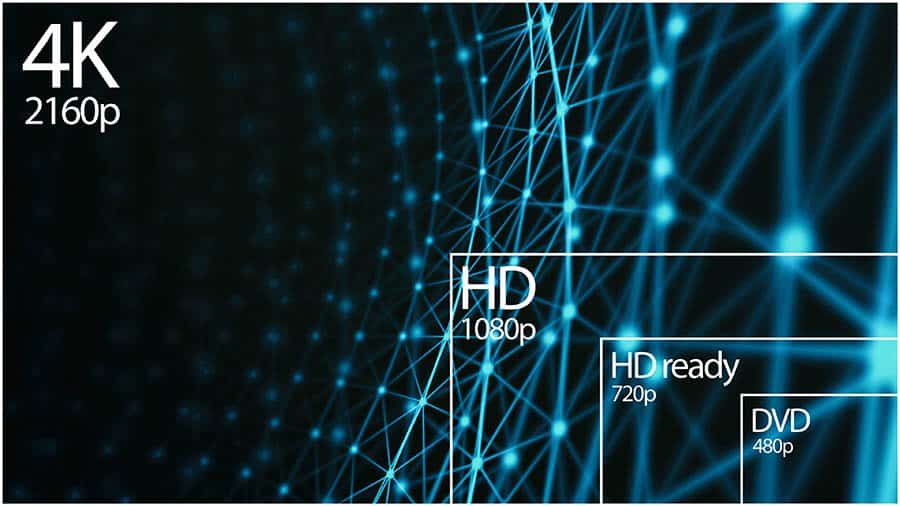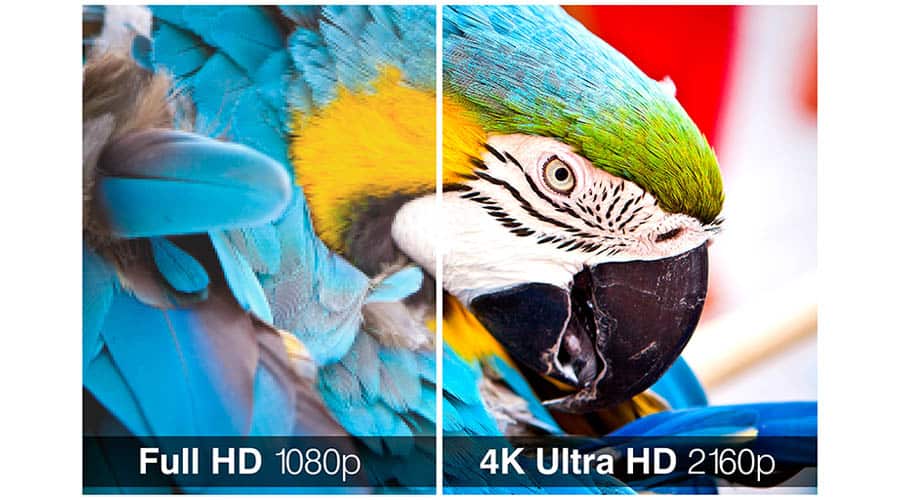When you’re looking for a TV, monitor or laptop screen, it can be difficult to know exactly what the specs mean. There are many terms thrown in there that people aren’t quite sure about, like having an IPS display or a description of the laptop’s bezels.
However, one thing that confuses people more than anything else is the resolution of your display, and the overall effect it has on your image quality. The debate with 4K vs 1080p isn’t new, but it is more relevant now than it ever has been.
You’ve probably seen that 4K monitors are advertised everywhere nowadays. As well as this, more and more 4K content is being made, with streaming services like Netflix leading the way. All that most people know is that with 4K, you’ll have an increased number of pixels, and it’s probably the better choice of the two.
But aside from a higher pixel count, what exactly does 4K even mean, and how does it compare to the 1080p which has become standard nowadays? Well, that’s what we’re going to look at today.
4K vs 1080p Resolution
The difference between 4K and 1080p is simply the amount of pixels that makes up the resolution of the monitor or screen you’re looking at. A 1080p screen stands for 1920×1080 pixels, which is the amount of pixels that fit into the display. A 4K display has 3840×2160 pixels, so almost 4K.
From this, we then know that a 4K display has 4 times the amount of pixels as 1080p content. This is the simple difference between the two, and it’s the reason why 4K is referred to as UHD, or Ultra High Definition. You can also get 8K monitors nowadays as well, which is as you’d expect – 7680x4320p.
So with four times as many pixels as 1080p, it seems pretty clear that it should be what you opt for. But in some cases, it may not actually be worth it, and it really depends on your screen size.
Is 4K better than 1080p?

If you’re wondering which one would be a better choice for you, then the likelihood is that a 4K would be the better option.
A 4K monitor is just going to give you a higher resolution than with a 1080p monitor, so there’s not many reasons not to opt for a 4K display – if you can afford it.
Why 4K is better
4K TVs tend to be pretty popular now, and if you’re looking for a larger television, then most of the market will be 4K.
If your television is large enough, or you’re close enough to the screen, then you’ll easily be able to see the difference in picture quality. The bigger the screen, the more noticeable the pixels are.
So, it makes sense that 1080p TVs have declined in popularity. They’re still pretty common sub 40 inches, at it’s difficult to see the difference between 1080p and 4K with the human eye on a smaller TV size. But for larger sizes, 4K TVs are going to be much better.
Why you might want to stick to 1080p
Although 4K is good, it’s not going to be the best choice for everybody out there. A higher quality of image is great if you’re watching films, but when it comes to gaming and watching YouTube videos, it may not even be necessary to have more pixels.
Here are a few reasons why you might want to stick with 1080p instead of switching up.
What Else to Consider
Although deciding between the resolution of your screen is important, there are other aspects that are also going to have an effect on the quality of your picture.
One of these is integrated IPS technology into an LCD screen, which will help to produce better colours, as well as making a massive difference when you’re looking at the screen from different angles. The colour range of your device is pretty important.
This is why I recommend that people opt for a laptop with an IPS display when on the hunt for a new laptop. However for gaming, I’d recommend that you opt for a TN screen as opposed to IPS, as IPS has the slower response times of the two.
Other things that you’ll want to consider are the refresh rate, especially when gaming. It’s probably more important than the resolution when it comes to playing competitive games, as a responsive display is valued over a high resolution.
But in relation to our topic, the size of your display is going to be a massive factor in whether to opt for 4K or not. There’s no point buying a 28 inch 4K TV if you’re going to watch it from a distance, as you’re unlikely to see the benefits of 4K with the human eye.
Does watching 1080p look blurry on 4k?

Often, people will wonder whether their 1080p Blu-ray player or film will look a bit strange on a 4K TV, as it might end up being a bit blurry.
Theoretically, the answer is that no, it won’t be blurry at all – but obviously it won’t be in 4K either! It should just show as it would in a 1080p television. However, sometimes this isn’t actually the case.
The reason for this is scaling. If your 4k monitor doesn’t have a inbuilt scaling process, then it may struggle to show a 1080p resolution image on your 4k screen. And therefore, you might end up with a worse picture than if you had a native 1080p resolution.
Can you even notice the difference between 4K and 1080p?
A common question about 4K televisions is whether you’re even going to notice the difference between a 4K TV and a 1080p TV. The answer to this is, it really depends on the size of the television, and the distance you are away from the screen. For example, if you have a 24 inch monitor and you’re quite far away from it, then you’re definitely not going to be able to see the difference. But if it’s a 50 inch TV in your lounge, then you’re going to see the difference between 1080p and 4K.
Should I buy 4k or Full HD?
You’ll often see companies use terms like Full HD without really saying what they mean. Full HD is just another way to say 1080p, which isn’t as detailed as a 4K tv or monitor. If you’re happy with a lower resolution, then going with 1080pm isn’t a bad idea.
Is 4k and UHD the same thing?
Whilst UHD is typically referred to as 4K, it’s not actually 4K in pixels. UHD has 3840 pixels, whilst true 4K (or cinema 4K) has 4096 pixels. Though it’s a small difference, it’s something to watch out for if you’re getting a new 4K screen.
Is 4k worth it over 1080p?
All in all, for the majority of people you’re hardly going to notice the difference between the two on a smaller TV. If you’re using a larger TV and you want a good home cinema experience, then I say go ahead and opt for a 4K TV. And if you’re thinking about a laptop, then because you’re so close, you’re really going to see the difference in 4K resolution.
Why does my 4k TV not look 4k?
The truth is that a lot of the television and films that we watch are actually still made in 1080p resolution. This means that it doesn’t have enough detail to be shown in 4K, so it won’t actually be any better than it would on a regular 1080p television.
Conclusion
All in all, if you can afford to opt for a 4K monitor or a laptop that has a 4k display, then I say go for it. The positives far outweigh the negatives, with the only real restriction being financial. For televisions and a larger screen size, it’s almost definitely going to be worth upgrading.
However, there’s really nothing wrong with a 1080p screen either, so if you don’t want to upgrade, then you don’t necessarily have to – a 1080p resolution is still fine.